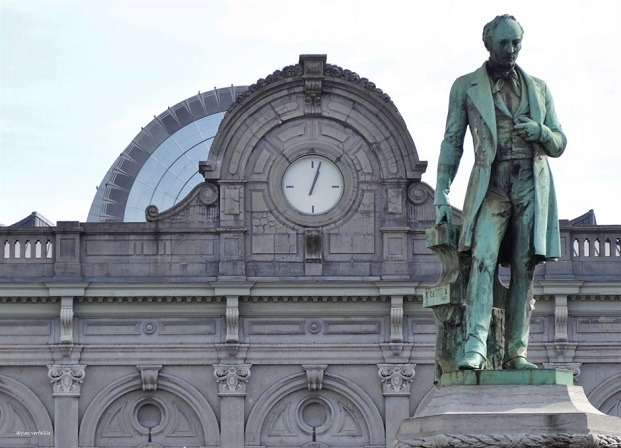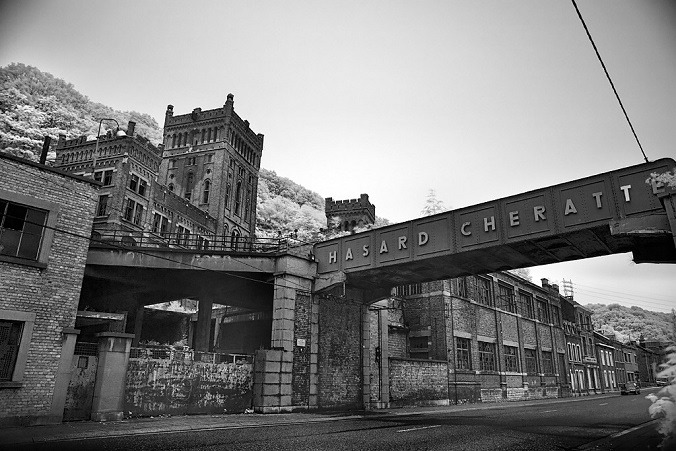Today a small country renowned for its linguistic battles, it is hard to imagine that only 150 years ago, Belgium was the first industrial nation on the Continent and second in the world. Karl Marx – who lived in Brussels from 1845-1848 – called Belgium “the paradise of Continental Liberalism”. In 2017, CMI (Cockerill Maintenance & Ingénierie) celebrated its 200th anniversary in Seraing, near Liège. Against this background, we trace the roots of Belgium’s current political and economic situation.
Belgium was the first continental country to follow the UK into the industrial revolution due to the introduction of the steam engine at the end of the 18th century. It started by industrialising the textile industry in Gent (cotton) and in Verviers (wool). Under the French administration from 1795-1814, coal was mined in the Borinage (southwest of Mons, in the province of Hainaut) to feed Paris via the river network.
But Belgian heavy industry really took off during the Dutch rule of the country from 1815-1830. William I wanted the south of his realm to feed the north with industrial products. He supported industry tycoons such as John Cockerill, an Englishman who had come to Verviers with his father to build textile machinery. In 1817, the Dutch king sold him the former castle of the Prince-bishops of Liège at Seraing with the task of developing steel manufacturing in the region. As recognition for his services to the country, a statue of John Cockerill can be found right in the middle of Place Luxembourg in Brussels' European quarter. The King of the Netherlands also founded the Société Générale in 1822 to boost national development. The bank changed its name to Société Générale de Belgique in the early 20th century.

Statue of John Cockerill in Place Luxembourg, Brussels.
The first industrial revolution saw clusters of industrial activities located near the needed energy and raw materials. Liège already had some proto-industry with forges and gun manufacturing, while Charleroi had its nail factories, so they were ready to embrace coal mining, steel and other metal construction industries. People came from the countryside to work in the industrial areas. There was no social security at the time and workers organised themselves. They created the mutualités (social security organisations), which were eventually incorporated by the state, and still exist today.
Factories were built next to transportation lines, be it rail or rivers. The Brussels-Charleroi canal was inaugurated in 1832: it linked the mines in the south of the country to the North Sea, via Brussels. The industrialisation of Brussels started when the canal opened.

The Brussels-Charleroi canal, 1966.
The continent’s first coke furnaces were put into service in Wallonia in 1827. After a bit of post-independence turmoil in 1830, due to the loss of the Dutch market, Belgium outperformed all its neighbouring countries with a massive growth spurt from 1840-1872. It grew almost as fast as the US. The average productivity per furnace was the highest in the world. Charleroi led global glass production. And in 1850, Belgium had the highest density of railways per square kilometre.
The original north-south division
English competition proved too strong for the Belgian textile business, which collapsed in 1840 and made way for heavy industry. Flanders was hit hard and abandoned by the liberal Francophone elite, which ran the country and its national banks. The influence of the boerenbond (farmers’ trade union) grew in rural Flanders, which was mostly Catholic. A fundamental division in Belgian society emerged: on the one hand, the French-speaking liberal bourgeoisie in the south supported by the high clergy and focused on the industrial bonanza in Wallonia, and on the other, the dense, rural, Catholic population of Flanders, supported by the low clergy and local banks – the perfect foundation for the future Christian Democrats of the Flemish socio-Christian party.
In 1892, 44 of the 50 biggest companies in Belgium (excluding banks) were heavy industries and mainly based in Wallonia. But a general economic decline had already started and would last until 1896. It was time to look abroad and lots of industrial groups reliant on the Société Générale de Belgique (e.g. Empain, Cockerill) went to build railways overseas, including in Congo. Belgium also became the first foreign investor in the coal basin of Donbass (now eastern Ukraine), ahead of France. The nationalisation of industry by the Bolsheviks in 1917 however, caused huge losses.
Meanwhile, the centre of Belgium (the Brussels-Antwerp axis) was gaining momentum with new industries. Gevaerts (photography) was founded in Antwerp in 1894. After the First World War, Ford and General Motors came to Antwerp, and Renault to Brussels (Vilvoorde). The year 1917 also brought a change in paradigm: coal was found in Limburg (eastern Belgium). Electricity generation, glass, petrochemicals, non-ferrous metals and artificial fibres followed in Flanders. But the crisis of the 1930s hit Wallonia hard and the Flemish movement, linked to Flemish employers, had its revenge: it demanded a Flemish institutionalisation of the northern part of the country and a linguistic re-balancing in state entities, which until then had been heavily dominated by French speakers.
After the Second World War, Wallonia’s heavy industry moguls gave the illusion that their production assets were competitive. But this would only last until other European countries had rebuilt – and hence modernised – their own industrial base. The weaknesses of Wallonia’s industry became more and more apparent.

Hasard Cheratte: an abandoned coal mine in Cheratte, Liège.
At the end of the 1950s, politics changed: government pumped up salaries to boost private consumption, launched huge infrastructure programmes (motorways, railways), opened industrial zones and welcomed foreign capital. The latter went to Flanders, which had become the gateway to the German motorways and booming Ruhr area thanks to the King Baudouin motorway. Refineries developed in the northeast of Flanders. Small industries flourished in the west, precisely where the textile crisis had hit the hardest in the 19th century. Local banks and the powerful boerenbond helped intensive agriculture to thrive. Sidmar (a subsidiary of Arbed, a steel manufacturer from Luxembourg) settled in Gent in 1962 to produce the first maritime steel of the country.
In Wallonia, the coal crisis of 1955-58 destroyed the last illusions. It was not only an industrial but also a social crisis. Wallonia was not diversified enough. Socialism, anti-capitalism and strong workers’ movements were strongly rooted and did not help attract foreign investors. Moreover, local politicians were risk-averse and turned to past industries and business models rather than boosting entrepreneurship. The consequences were clear: modernisation stayed away along with foreign investors, who would only come if large amounts of government largesse i.e. public money was offered to them, making the region even more vulnerable to decisions taken elsewhere.
Catching up
The situation did not change until the oil shock of 1974 because there was economic growth in Europe. Hence reforms were postponed. Investments were defensive, aimed at maintaining the workforce in the traditional sectors (steel, glass and cement). The state played a complicit role by generously financing unemployment and early retirement.
Meanwhile, stimulated by hosting the European Communities institutions, the tertiary sector grew significantly in Brussels, as did the public sector, which boosted the non-merchant part of the economy. In 1960, Flanders’ industry had caught up to Wallonia’s in terms of contribution to GDP. And this trend intensified with, in the north, Flanders attracting the companies of tomorrow in the Golden Sixties while in the south, Wallonia fell back on itself, taking advantage of the state’s budget to pay its social bill and, in the process, reducing its industrial base.
The 1974 crisis emphasised the new service orientation of the Belgian economy, with international holdings pulling out of industry and investing in finance. The steel crisis hit Belgium and unemployment exploded, in Wallonia more than anywhere else. Flanders, with more up-to-date means of production, resisted better. Wallonia’s decline (and to a lesser extent Flanders') would continue with globalisation and the delocalisation of production facilities to countries with cheaper labour and fewer social and environmental constraints.

The general strike of December 1960 to January 1961.
Nevertheless, two events have deeply contributed to the division of the country as we know it today. One was the Question Royale in 1950-51, when the citizens of Belgium voted in a referendum on whether King Leopold III should return to Belgium, given his acquiescence towards Germany during the Second World War. Flanders voted for his return, whereas Wallonia voted against. In the end, the king abdicated in favour of his son, Baudouin. The second event however, was directly linked to Belgium’s industrial history: the general strike of December 1960 to January 1961.
The strike was triggered by a proposed austerity plan from the government, which led to a quasi-insurrection in the country. Three-quarters of the strikers were from Wallonia. Today, some see it as an upswell of Walloon identity. The strike’s leader, André Renard, was an ex-Cockerill worker turned trade unionist. The strikers wanted more economic autonomy and freedom for Wallonia, something that would finally become reality in 1993 with the creation of the three regions within a federal state.
Today, Flanders is still a strong economic player with its competitive industries and Wallonia is trying to rid itself of a mindset turned towards the past. From industrial giant to the sometimes absurd little country we know today, Belgium is still looking for an identity. If it is still what Karl Marx called it, “the snug, well-hedged, little paradise of the landlord, the capitalist and the priest”, it is now also a small paradise for civil servants, be they from one of its seven institutional entities, its communes or the European institutions. Belgium’s industrial history has shaped its institutional organisation. That process is not yet over. The popularity of the nationalists in Flanders and of the extreme-left Parti des Travailleurs Belges (PTB) in Wallonia, could shake the country further. The national motto L´union fait la force is on probation.
By Hughes Belin

